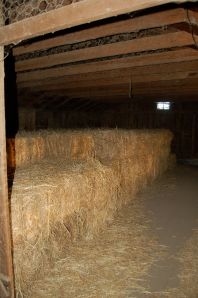“It must be wonderful to not have a huge grocery store bill!” I’m told many a time, by people who know we have a full-cycle farm (i.e. milk, meat, chickens, gardens, etc). I laugh and tell them that at this point, I don’t pay the grocery store, I pay the feed store! WE won’t REALLY have it together until we can feed our livestock.
We bought some apples (a health food right?) at a small market, rather than buying junk food . Took one bite and had to spit it out… you could taste the chemical coating on the apple. I don’t know if I’m getting more sensitive or if it’s getting utilized in heavier doses.
I know that I’m reading you can no longer wash the stuff off… it’s absorbed systemically.
Producing your own food, overall it is NOT cheaper; just a lot, and I mean, a lot better quality.
Quality in value and in taste... and probably even more importantly… not exposed to so much “crud” that is used to produce industrial food (neurotoxins, pesticides, antibiotics, hormones, etc). Upfront it’s not cheaper but we won’t have the same health issues, and as those costs are sky-rocketing, we are saving tons of dollars long-term. Not to mention, just the additional quality of life in not being sick.
OK here’s my spiel: find an organic farmer/market/CSA. Not because they need it, but because YOU need it, especially your children! Most of this “toxic crappola” did not come on the scene until the 1980’s and has escalated since then. An occasion hit of “crap” our systems can generally detoxify and cope with.
It’s the day in, day out constant onslaught that is creating the epidemic of chronic diseases.
We are working toward becoming a “sustainable” farm, meaning that the farm will provide for our needs in general. Not everything. Traditionally one would trade for other services/products. But all the same, farms were not mono-crops.
“Doing” just one thing would exhaust your soil over time, whether crop or a particular livestock. Just raising corn, just raising pigs would overload you: you would pull out too much of one thing, and dump to much as waste, of one thing, to be healthy. Farms that did that would eventually exhaust the soil (or contaminate it), people would move on to new territory. The “westward movement” was a significant part of that process with all the “new world” land available.
Think of just eating french fries, or just broccoli, or just chicken. UGGH. That would get old real fast. I think it’s a built in safety mechanism. Your body won’t let you eat just one thing, on purpose. It’s the satiation factor. You know how the first chocolate chip cookie, out of the oven, is heavenly… but by the 4th one you’re starting to feel FULL (OK, so for some of us it’s the 10th cookie)!
Typically, in the 1800’s, there was the family garden (food raised to be utilized by the family) and then the main crop that would be used for selling (cash trade) and then food raised to be utilized by the livestock.
People often ask why we focus so much on miniature/compact livestock. Mini-horses, mini-cows, & mini-milk cows, in particular. Historically at least one third of a farms products went to feed the livestock. That means if you had a 3 acre farm (which we basically do), one acre would be in full production just to feed the animals that would provide your power labor such as transportation, pulling a plow, hauling things, or provide meat, milk, butter, cheese, etc. The other two acres are what supported the farm.
The problem in the USA is that bigger is better, except when you have to feed it!
Then the food bill goes through the roof, either in terms of producing it (maybe half the acreage would have to feed the livestock instead of one third), or purchasing it.
By downsizing our larger livestock we feel like it is more cost effective in general plus the supporting costs are less. Less fencing, housing, trailer size, pasture damage due to weight, etc.
How much is an acre of land valued in California (an hour north of San Francisco)? An easy $100,000 acre. If we try and feed our livestock from our land… can you imagine covering the cost of $100,000/an acre to produce feed.
Smaller livestock mean lower food needs! We manage much of the cost by importing feed grown on much “cheaper valued” land. But it used to cost us $5/bale of good feed and now it’s up to $15-20/bale. In FIVE years.
The REAL questions is NOT, “Why is organic food so expensive”, but “WHY is industrial food so cheap?” But I don’t think industrial food is going to be “cheap” much longer…
And that “grocery bill” is going to get a heck of a lot more expensive. Cultivate your local farmer… he may be the best value to be had, in the near future!




